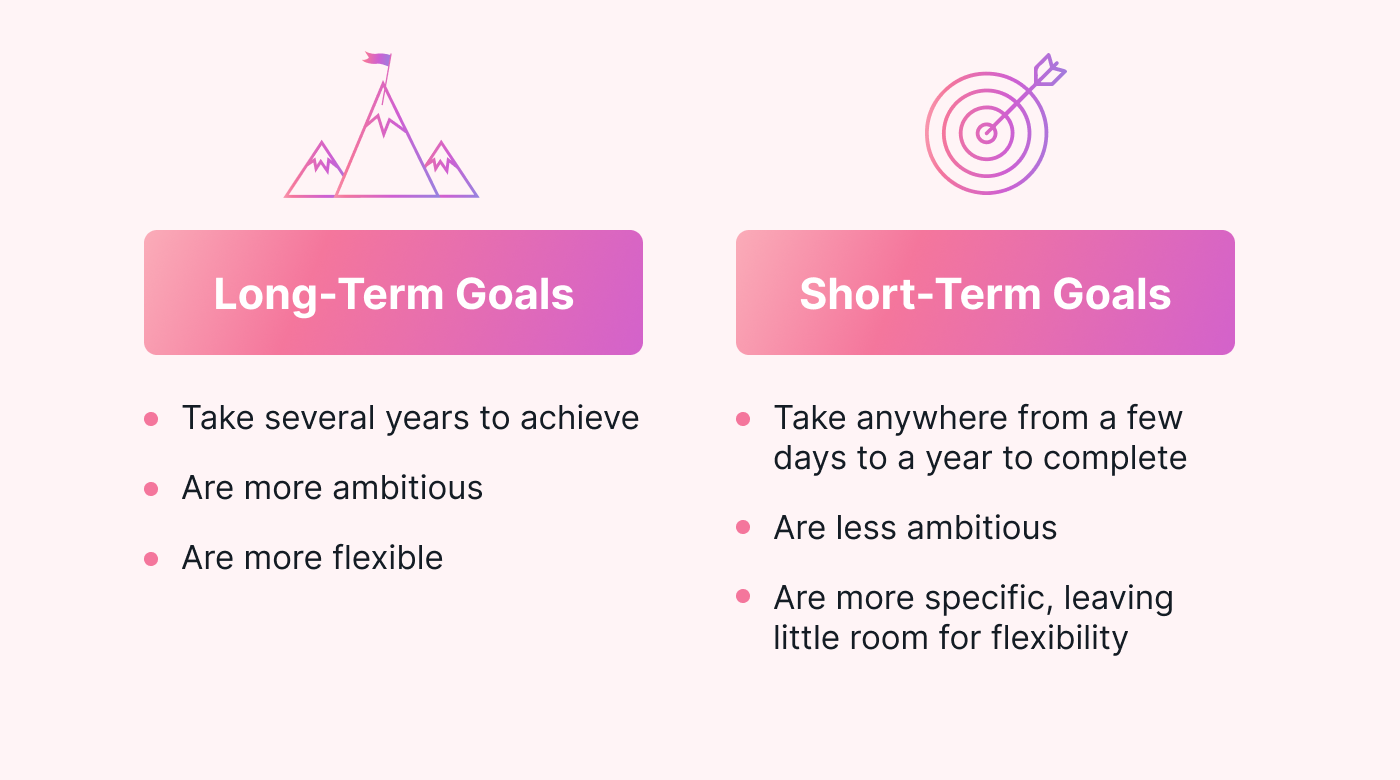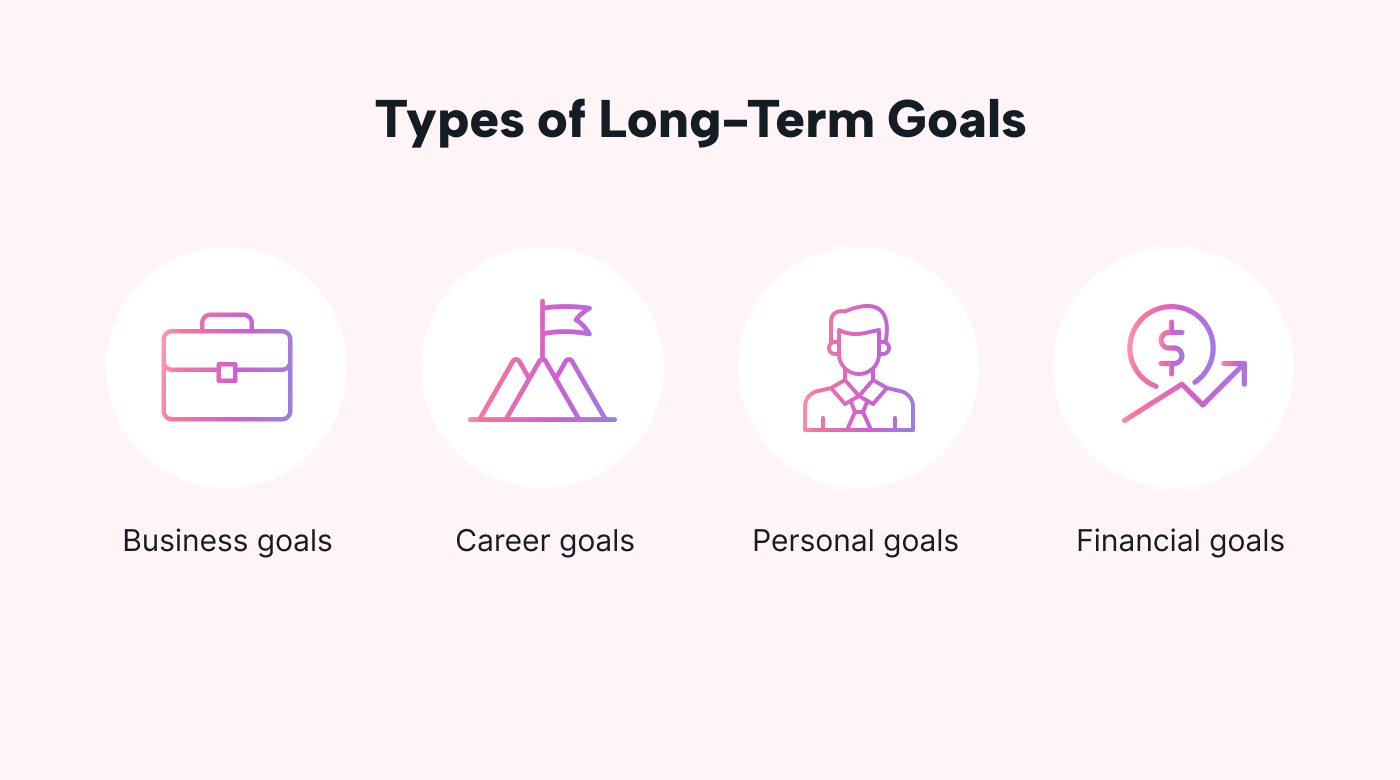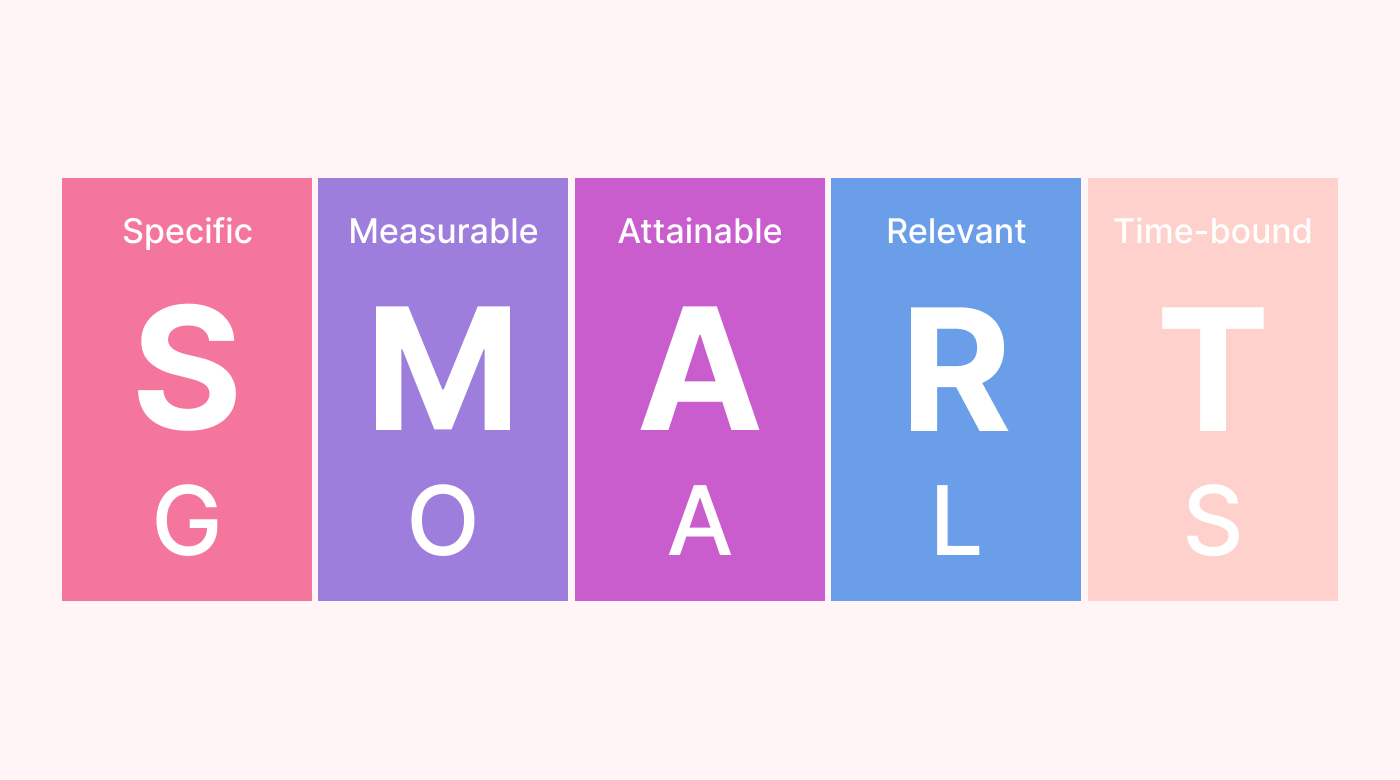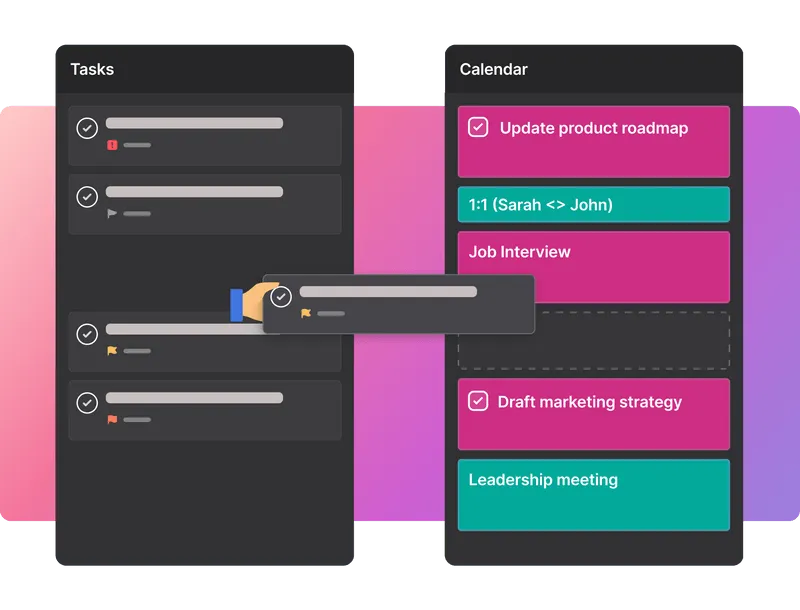Setting long-term goals is important if you want to succeed in your life and career.
In fact, over 1,000 studies have found that setting lofty, specific goals is linked to higher levels of performance, motivation, and persistence.
But what exactly are long-term goals? How can you set them? And most importantly, how can you achieve them?
Let’s look at long-term goals, why they’re important, and how you can make them a reality. We’ll also give you a list of 50 long-term goal examples so you can be inspired to aim high when setting your goals.
What are long-term goals?
Put simply, a long-term goal is an objective you want to achieve in the future — but one that’ll take a fair amount of effort and time. They’re not something you can achieve in a week or even a year; long-term goals are big goals that concern your health, finances, or career.
To achieve long-term goals, you need to:
- Plan carefully to make sure each goal is realistic and achievable
- Include different milestones to ensure progression
- Consistently put in the work (even if the results are taking longer than expected)
- Remain focused and accountable throughout the process
Difference between long and short-term goals
While both long and short-term goals have end objectives, their scales and the time frames required to achieve them are different.

Short-term goals can take anywhere from a few days to a year to complete, whereas long-term goals can take five years or longer.
Long-term goals are also often made up of short-term goals or smaller milestones that help you stay accountable and measure your progress.
For example, if your long-term goal is to buy a house, you may have several short-term goals to help you afford the property, such as getting a promotion, investing in stock, or taking out a loan.
Since long-term goals are achieved over a long period, they’re more flexible than short-term goals. This is because circumstances that are out of your control (such as inflation when saving to buy a house) may change, and you may need to adjust your overall objective or timeframe as a result.
On the other hand, short-term goals are more specific and often list specific tasks that need to be completed over relatively short periods.
Why is it important to set long-term goals?
Without setting long-term goals, it’s impossible to know where you want to go — let alone how you’ll get there.
In 2018, John Doeer, an American investor with a net worth of over $4 billion, spoke at a TED conference about the importance of goal setting. He went so far as to say that the “secret” to success is setting the right goals.
Not only do long-term goals give you a long-term vision, but they also inspire and motivate you to take deliberate, small actions to help meet them.
They help you stay focused and “keep your eyes on the prize.” As a result, you’ll be better able to organize your time, projects, and resources to achieve the things you truly want.
According to Positive Psychology, setting goals can also help trigger new behaviors that’ll help you gain momentum in your life.
Long-term goal setting can even promote a sense of self-mastery since your goals will push you to step out of your comfort zone and do things you never thought you were capable of.
Examples of long-term goals
You can set different types of goals for the business, career, personal, and financial areas of your life.

Here are some examples of what these goals could look like:
Long-term business goals
- Grow a successful business
- Reach a monthly revenue of X amount
- Expand your business to a new country or region
- Hire a skilled team of workers
- Travel the world while managing your company remotely
- Rebrand your business
- Increase employee satisfaction and retention
- Leave a legacy
- Develop a personal brand
- Acquire a competitor company
- Grow your customer base to X amount
- Increase shareholder value
- Become a public speaker
Long-term career goals
- Find your dream job
- Improve your work-life balance
- Master a new job skill
- Become a company executive
- Work internationally
- Retire from full-time work
- Shift to a new career path
- Experience career stability
- Achieve a salary of X amount
- Expand your professional network
- Mentor other employees
- Pursue further education
- Become an expert in your industry
Want to set better goals for your career? Read our ultimate guide to setting professional goals.
Long-term personal goals
- Buy a house
- Live abroad
- Go on your dream vacation (such as a two-week trip to Hawaii)
- Achieve your ultimate fitness level and weight
- Learn to cook like a chef
- Complete a difficult event, such as a marathon
- Have or adopt a child
- Maintain your ideal weight
- Find your life partner
- Become a better parent
- Become a better spouse
- Emigrate to a different country
- Learn to play an instrument
Long-term financial goals
- Become a millionaire
- Improve your credit score
- Pay off your large debts
- Grow your savings account balance
- Invest in something big
- Build an emergency fund
- Saving for a college fund for your kids
- Pay off your car
- Fund your retirement
- Invest money in stock or properties to get X amount of return on investment
- Become financially independent
According to a 2022 Hearts and Wallets research report, long-term financial goals matter to 82% of American households.

How to set and achieve long-term goals
Setting long-term goals can be tricky and sometimes even overwhelming. Here are some general guidelines you can follow to make it easier:
1. Think of where you want to be in 10 years
You need to visualize your “perfect” future before you even think about creating long-term goals.
Remember that long-term goals require commitment and take several years to achieve. So, you don’t want to end up setting a goal that doesn’t fit into your life or business.
If you’re setting a long-term personal or career goal, it needs to align with your values and be something that matters to you. On the other hand, if you’re setting a business goal, ensure that it aligns with your company’s mission, vision, and values.
Having something to aim for that’ll really impact your life or business will help you stick to your goal — even during uncertain times.
2. Write SMART goals
The SMART goals framework is a popular method used for setting long-term goals. It focuses on helping you set goals that aren’t only suited to you and what you want but that are also realistic and achievable.
SMART stands for specific, measurable, attainable, relevant, and time-bound.

When setting SMART goals, ask yourself the following questions:
- Specific: What exactly is it that you want to achieve? Make the goal as specific as possible. For example, if you’re setting a financial goal, include a specific monetary amount.
- Measurable: How will you know whether you’ve achieved your goal? Set up key performance indicators that’ll make it clear whether your goal has been met or not.
- Attainable: Is your goal possible to achieve? Make sure it’s realistic and can be reached within the specified time frame.
- Relevant: Does your goal contribute to your overall personal, career, or business growth? Ensure you set a goal that fits into your dream life or career. It needs to be focused on what you truly desire.
- Time-bound: When do you want to achieve your goal? Choose a day you can use as a deadline. The more specific with it you get, the better.
3. Reverse-engineer your goal
Long-term goals can be overwhelming since they’re far more complex than short-term goals. They leave room for you to become demotivated since they can sometimes seem unattainable.
That’s why they should be broken down into short-term, bite-sized, less intimidating goals.
In other words, you need to create a more manageable action plan.
You can do this by reverse-engineering the objective. Start at the end and work backward to determine the smaller tasks that need to be completed for you to attain your ultimate goal.
Like long-term goals, each short-term goal should be based on the SMART framework.
For example, if your long-term goal is to grow a successful business, your short-term goals might include things like the following:
- Writing a business plan
- Gaining funding
- Opening a business bank account
- Hiring your first employee
4. Prioritize your goals
You can use a planning system such as Motion's AI task manager to prioritize your tasks and manage your schedule — and in doing so, make it easier to achieve your long-term goals.

Motion allows you to use time-blocking to set aside a specific amount of time to complete different tasks. This helps you to be more productive and get the work done!
With Motion, you can also merge your personal and professional goals — making it possible for you to work on home and work responsibilities on the same day without feeling overwhelmed.
You can also move tasks around whenever emergencies arise so you don’t forget about them — and rest assured that your tasks will be completed no matter what.
5. Make a plan to track your progress
This is where the “measurable” part of your SMART goal comes in. You need to make sure that your long-term and short-term goals are measurable.
For example, if you have a short-term goal of improving your networking and communication abilities, you could measure it through the tasks you complete.
Thus, your tasks may look something like this:
- Reaching out to three new people in your industry per day via email
- Taking a one-week communication course
- Going to a networking event
- Communicating more during work meetings
Completing each of these subtasks with the help of a tool like Motion could help you move toward completing your bigger goal. You can set the urgency of each task, its due date, and much more.

6. Be willing to make changes
As mentioned above, unexpected obstacles sometimes arise. And often, these obstacles are out of your control.
It’s important to remember that things change — and that’s okay.
When you’re aiming for a long-term goal, it’s completely normal for things to occur that knock you off track or for your long-term goal to shift. After all, a lot can happen in 5–10 years!
Rather than becoming demotivated when things change, maintain a mindset of flexibility. If you focus too much on a fixed outcome, you might miss out on other opportunities.
For example, if you’ve set a goal to emigrate to a specific country, but that country’s financial state declines dramatically — no longer making it a viable option — be willing to shift your goal. Look into other countries that could be better options.
Ready to set ambitious long-term goals?
Now that you know how to set your long-term goals, you can get to work setting business and personal goals that resonate with you and your dream life.
Setting these goals may take some soul-searching, but once you have them in mind, you can start working on your plan to get there.
Be sure to use a to-do list app, as this will help you measure your progress toward your goals much faster.




